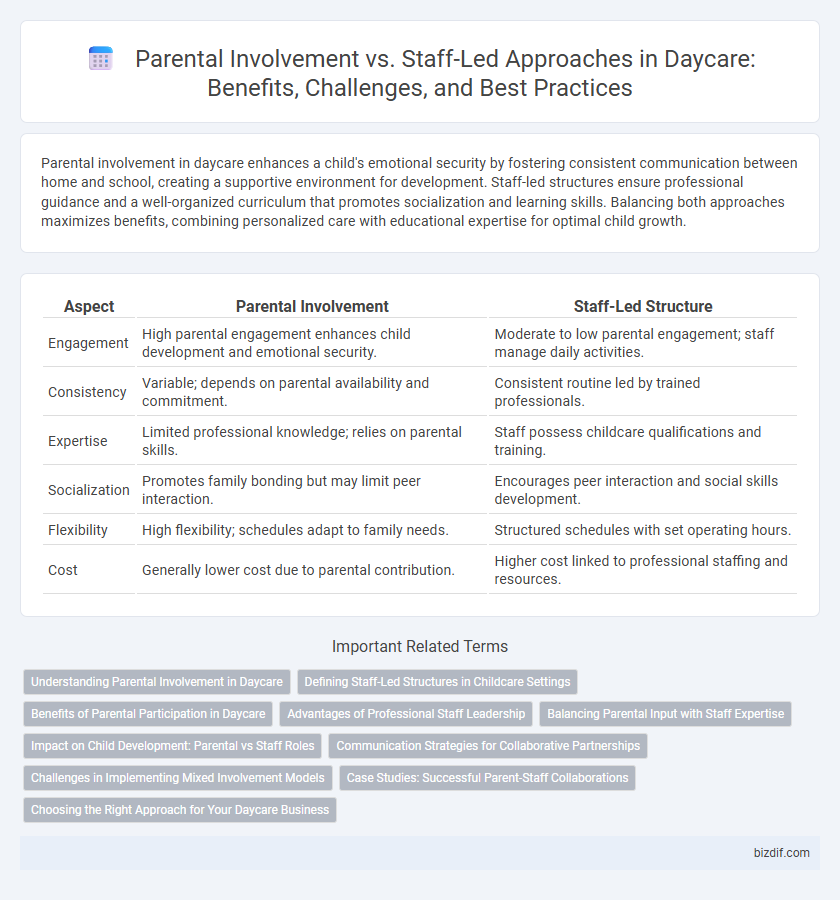Parental involvement in daycare enhances a child's emotional security by fostering consistent communication between home and school, creating a supportive environment for development. Staff-led structures ensure professional guidance and a well-organized curriculum that promotes socialization and learning skills. Balancing both approaches maximizes benefits, combining personalized care with educational expertise for optimal child growth.
Table of Comparison
| Aspect | Parental Involvement | Staff-Led Structure |
|---|---|---|
| Engagement | High parental engagement enhances child development and emotional security. | Moderate to low parental engagement; staff manage daily activities. |
| Consistency | Variable; depends on parental availability and commitment. | Consistent routine led by trained professionals. |
| Expertise | Limited professional knowledge; relies on parental skills. | Staff possess childcare qualifications and training. |
| Socialization | Promotes family bonding but may limit peer interaction. | Encourages peer interaction and social skills development. |
| Flexibility | High flexibility; schedules adapt to family needs. | Structured schedules with set operating hours. |
| Cost | Generally lower cost due to parental contribution. | Higher cost linked to professional staffing and resources. |
Understanding Parental Involvement in Daycare
Parental involvement in daycare significantly enhances child development by fostering consistent communication between parents and staff, ensuring that children's emotional and educational needs are met effectively. Active collaboration allows parents to reinforce learning and behavioral goals established by daycare professionals, creating a cohesive support system. Research indicates that children with engaged parents demonstrate improved social skills, higher academic readiness, and greater emotional security compared to those in staff-led structures with minimal parental interaction.
Defining Staff-Led Structures in Childcare Settings
Staff-led structures in childcare settings establish clear routines, guided by trained professionals who design and implement daily activities to promote developmental milestones and social skills. These frameworks prioritize consistency, safety, and educational goals, ensuring that each child receives tailored support within a structured environment. Parental involvement complements this model by reinforcing learning at home but relies on the staff's expertise to shape foundational caregiving and instructional strategies.
Benefits of Parental Participation in Daycare
Parental participation in daycare enhances children's emotional security and fosters stronger family-child bonds, leading to improved developmental outcomes. Active involvement allows parents to better understand their child's daily experiences and collaborate with staff to tailor educational and care strategies. Research shows that children with engaged parents demonstrate higher social skills, language development, and adaptability within daycare environments.
Advantages of Professional Staff Leadership
Professional staff leadership in daycare ensures consistent implementation of evidence-based educational practices tailored to child development milestones. Trained educators possess expertise in managing diverse needs and behaviors, promoting a safe and stimulating environment that fosters social, emotional, and cognitive growth. This structured approach minimizes conflicts and maximizes individualized attention, resulting in enhanced learning outcomes compared to predominantly parent-led settings.
Balancing Parental Input with Staff Expertise
Balancing parental input with staff expertise in daycare centers enhances child development by integrating family values with professional knowledge. Encouraging open communication channels allows staff to tailor educational activities while respecting parental preferences, fostering a collaborative environment. This synergy supports holistic growth, ensuring children receive consistent care and learning both at home and in the daycare setting.
Impact on Child Development: Parental vs Staff Roles
Parental involvement in daycare enhances emotional security and promotes language and social skills through consistent reinforcement and personalized attention. Staff-led structures provide professional guidance with structured activities that develop cognitive and motor skills efficiently. Combining both roles creates a balanced environment, fostering holistic child development by merging emotional support with educational expertise.
Communication Strategies for Collaborative Partnerships
Effective communication strategies in daycare settings prioritize regular updates, open dialogue, and active listening to foster parental involvement and support a staff-led structure. Utilizing tools such as daily reports, parent-teacher meetings, and digital communication platforms enhances transparency and trust between parents and staff. Collaborative partnerships thrive when both parties share goals and feedback, ensuring consistent child development and well-being.
Challenges in Implementing Mixed Involvement Models
Balancing parental involvement with staff-led structures in daycare settings presents challenges such as inconsistent communication, differing expectations on child-rearing approaches, and potential conflicts over decision-making authority. Staff may struggle to integrate diverse parental input while maintaining professional standards and regulatory compliance. Effective implementation requires clear roles, ongoing dialogue, and tailored strategies to align family values with structured educational goals.
Case Studies: Successful Parent-Staff Collaborations
Case studies reveal that daycare centers with strong parental involvement paired with staff-led structures achieve higher child development outcomes and improved communication. Successful collaborations emphasize shared decision-making, regular parent-teacher meetings, and co-created learning activities. Data indicates these partnerships enhance children's social skills, emotional regulation, and overall satisfaction for both families and staff.
Choosing the Right Approach for Your Daycare Business
Balancing parental involvement with a staff-led structure enhances a daycare's effectiveness by fostering collaboration and consistency in child care practices. Prioritizing clear communication channels and setting defined roles between parents and staff ensures a supportive environment that promotes child development and trust. Tailoring the approach to the specific needs of the daycare community optimizes operational efficiency and enriches the overall experience for children and families.
Parental involvement vs staff-led structure Infographic

 bizdif.com
bizdif.com